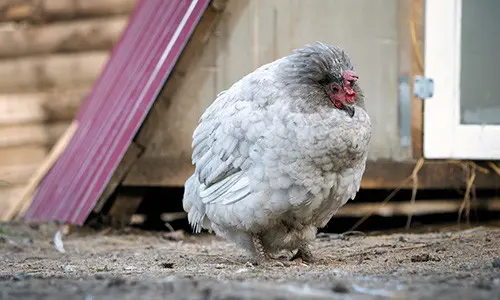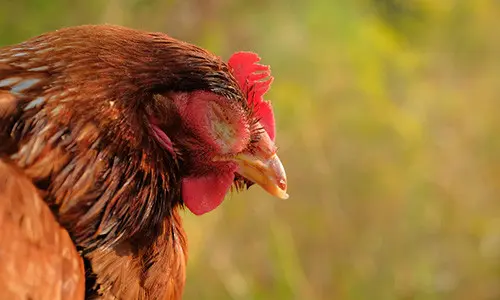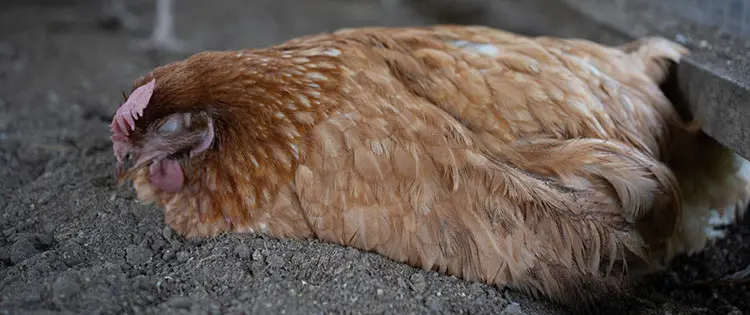Whatever you plan to do with your hens, keeping them happy and safe is always a top responsibility. A healthier flock of chickens will increase your hatchery’s profits.
The very first thing to do if you think your chickens could be ill is to closely monitor the flock.
Learning how to recognize and treat some of the frequent ailments that affect hens is a necessary part of keeping them. That’s what I’m offering you today.
Here are the five most common chicken diseases, how to recognize them, and their prevention tips.
Fowl Pox
You should be worried that your hens are getting fowl pox if you see white patches on their skin, white ulcers in their mouths, and a decrease in their egg production.
For fowl pox, there are many effective treatments. You may attempt to help them recover by giving them soft food and a clean, dry place to stay. Your birds have a good chance of surviving this sickness with the right care.
There is a vaccination available if you want to reduce the likelihood that your birds may ever have this illness. Otherwise, you should be aware that they can catch this illness through infected hens, and mosquitoes, and as it is a virus, it can also be spread via the air.

Bronchitis
Your hens may catch a cold just as people do, and it’s just as deadly. If your flock contracts the infection, you’ll see a decrease in egg production, a decrease in food and water intake, a possible discharge from the birds’ eyes and nose, and maybe breathing difficulty.
Regrettably, bronchitis is a condition for which little can be done. To prevent other diseases from developing while your birds are ill, you can give them medicines for a few days. Otherwise, you must wait it out.
There are a few forms of preventative immunizations against bronchitis, similar to those against chicken pox, however, they are not 100% effective. Good biosecurity practices and effective rodent control measures should help keep the minimum illness.

Fowl Cholera
One of the most contagious chicken illnesses that pose a risk to your chickens is fowl cholera. By ingesting a bacterial organism, one can get fowl cholera. The upper respiratory tracts or the mouth are the most common entry points for germs into the body.
Sometimes, even we don’t know that the hen is ill. However, a lot of affected hens may exhibit symptoms including apathy toward food and water, diarrhea, swollen wattles and joints, and difficulty in walking.
The most effective preventative strategies include a thorough cleanliness schedule. Since the disease is bacterial in origin, coops and yards should be kept dry to minimize wet patches and other moisture accumulations. Whether they are sick or not, you should use bacterins to treat your hens. These have the potential to both prevent illness and prolong the lives of afflicted hens.
Related: How You Can Find Out If Your Homestead Water Is Polluted Or Clean

Marek’s Disease
Chickens between the ages of 12 and 25 weeks are commonly affected by this illness, also known as fowl paralysis. Marek’s disease is probably the cause of any tumors your chick has acquired, abnormally shaped pupils (which generally cause blindness), or partial paralysis.
Sadly, nothing can be done to treat sick birds because this chicken illness is a type of avian cancer. It happens when the feather dander of an infectious bird is breathed in by a chicken. It is preferable to remove the bird from the flock as soon as possible since even if it survives, the disease will remain in it.
Despite how terrifying this illness sounds, immunizations are readily available. Marek’s disease vaccinations are available for young birds to help lower the chance of infection.

Newcastle Disease
The respiratory system is another way that this illness manifests. The birds will start having breathing issues, snot will start coming out of their noses, their eyes will start to look dark, and they’ll cease laying. Additionally, it is typical for the bird’s legs, wings, and neck to become paralyzed.
Other birds, particularly wild birds, can carry this illness. It is typically contracted in this manner. But if you handle an infected bird, you could spread the disease to other things like your clothes and shoes.
The great news is that adult birds typically recover and stop becoming carriers after contracting the illness, but the majority of newborn birds will perish from it.

The above-mentioned are the most common diseases among chickens.
Given the chance that at least one of these chicken diseases may eventually affect your flock, it is advisable to keep in mind the signs so you can cure your animals or seek medical attention for them as soon as you become conscious of a problem.
Additionally, it’s a good idea to keep track of general production statistics like feed and water usage, and egg production.
The first indication of a disease is frequently a decrease in productivity or a change in feed consumption.
You may also like:
How To Hide Your Valuables and Stockpile In Plain Sight When SHTF (Video)
Best And Worst Livestock For Homesteaders
10 Common Mistakes You Should Avoid If You Want To Raise Chickens
Livestock Animals You Should Start Raising For The Upcoming Economic Crisis



















